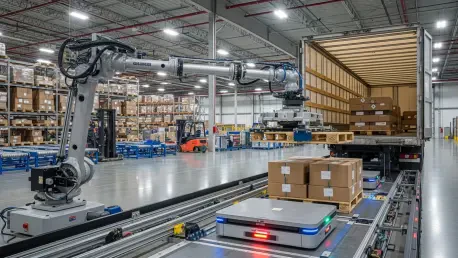Today, businesses of all sizes are striving to operate more efficiently and stay ahead in a rapidly evolving market landscape. Automation is a crucial tool driving this evolution, particularly in the logistics and warehousing sectors that deal with high demands for productivity and speed. Historically, automated trailer loading systems (ATLS) were exclusive to large-scale manufacturers and distribution centers, where freight was consistently shifted in high-volume, predictable operations. Yet, technology advances and industry changes have democratized these systems, making them feasible and appealing even for smaller companies and those in direct-to-consumer segments.
Democratization of Automated Systems
Traditionally, ATLS was thought to be reserved for large corporations with substantial budgets and space. The evolution of these technologies has introduced more inclusive solutions, providing options for businesses that previously couldn’t afford the financial or spatial investments. The introduction of modular and bolt-on systems, such as those seen with solutions like LoadMatic Lite, signals a significant shift in the market. These developments allow companies to integrate automation without major overhauls to existing infrastructure, leading to an enhanced return on investment (ROI). This affordability and scalability mean that businesses of various sizes and across multiple sectors can adopt partial automation gradually, taking the first steps toward comprehensive automation.
The financial benefits of ATLS extend to substantial cost savings over time, as businesses enhance throughput without significantly increasing labor costs. Furthermore, safety concerns in the logistics sector—prone to incidents due to high human interactions—are alleviated through automation. The effectiveness of ATLS in improving safety conditions by minimizing manual handling operations makes these systems particularly attractive. The solutions cater to specific industry needs, diversifying their applications from reducing trailer damage in cold chain logistics to eliminating contamination risks in pharmaceutical distributions. Therefore, even sectors with unique requirements find these automated systems beneficial.
Navigating Financial and Spatial Concerns
One of the primary considerations for any business looking to implement ATLS is the ROI, which typically needs to be realized within three years. This benchmark reflects a balance of ensuring financial viability while mitigating labor shortages and escalating operational costs. The pressures of maintaining high throughput have driven many companies to explore automation solutions. While ATLS offers various advantages, apprehensions about the initial costs and spatial limitations remain prevalent. These barriers can impede the decision-making process for companies hesitant to invest in technology perceived as costly and space-intensive.
Addressing these hesitations, contemporary ATLS solutions are designed to minimize space usage and are priced competitively. This approach significantly increases their appeal to businesses that might otherwise be constrained by physical limitations or limited capital. The ability to deliver ROI swiftly, some as quickly as 13 months, is a compelling reason for businesses to reassess their operational strategies. With modular systems that fit seamlessly into existing dock environments, companies can optimize how loads are handled, reducing manual dependencies and improving overall operational efficiency.
Beyond Throughput: Safety and Cost-Effectiveness
The advantages of ATLS extend beyond merely enhancing throughput and operational speed. They play a vital role in ensuring overall safety for both human workers and cargo. Automation reduces human interventions during loading operations, which traditionally exposed workers to hazards. Minimizing these interactions not only boosts safety but can also elevate consistency and accuracy, ensuring operations are reliably executed. The financial implications of reduced accidents and damages further contribute to the attractiveness of ATLS.
In sectors like pharmaceuticals or cold chain logistics, the precision offered by automated systems helps maintain product integrity and prevents spoilage or contamination. These industries benefit immensely from the precise control that automation offers, addressing concerns that cannot be managed through traditional manual processes. The reduced human contact ensures quality control, vital in maintaining regulatory compliance and ensuring customer satisfaction. This diversity in application demonstrates the cross-sectoral advantages of automated loading systems, making them a forward-thinking choice for businesses seeking enhanced safety and efficacy.
Transformative Potential of Diverse Solutions
The advent of diverse and cost-effective ATLS in the market marks a turning point for business strategies concerning logistical automation. It empowers smaller enterprises to embrace automation while remaining financially prudent. As options multiply, companies can choose systems that align with their specific needs and scale operations progressively. This flexibility allows smaller businesses to begin with modest investments, gauging automation benefits before committing extensively.
These developments present an opportunity to transition from traditional manual processes, fostering growth in operational capabilities and competitiveness. The advent of adaptable solutions like those of Joloda Hydraroll signifies a forward-thinking approach, bridging gaps that once seemed insurmountable for smaller players. Such systems are not only economically accessible but also allow gradual adoption, ensuring businesses enhance efficiency without undue pressure. As they navigate the complexities of modern logistics, companies find themselves better positioned to meet future demands, strengthening reliability and resilience.
Bridging to the Future of Logistics
In today’s fast-paced market environment, businesses of every size are determined to enhance their efficiency to stay competitive. Automation has become a key driver of this shift, particularly within the logistics and warehousing sectors, which face a constant need for high productivity and rapid operations. In the past, automated trailer loading systems (ATLS) were predominantly utilized by large manufacturers and distribution centers. These venues required continuous transportation of goods in large quantities and under predictable conditions. However, due to advancements in technology and evolving industry dynamics, these sophisticated systems are now accessible and beneficial to smaller enterprises and those serving the direct-to-consumer market. This shift not only levels the playing field for smaller entities but also encourages innovation and increased operational agility. As a result, even small-scale businesses can now leverage automated solutions to streamline their logistics processes, ensuring they remain competitive in an ever-changing marketplace.








